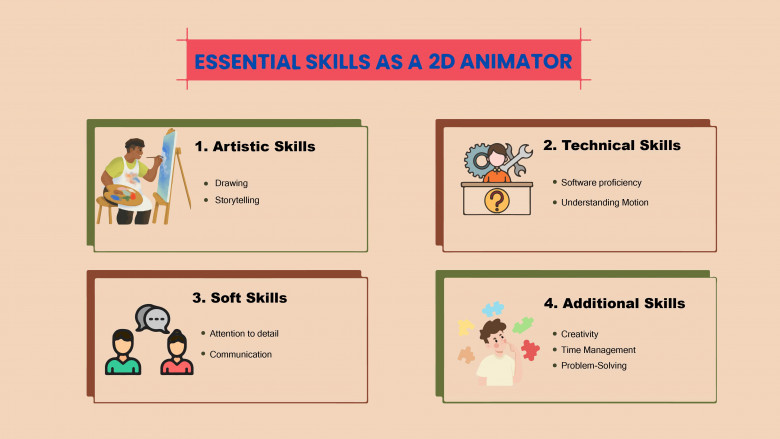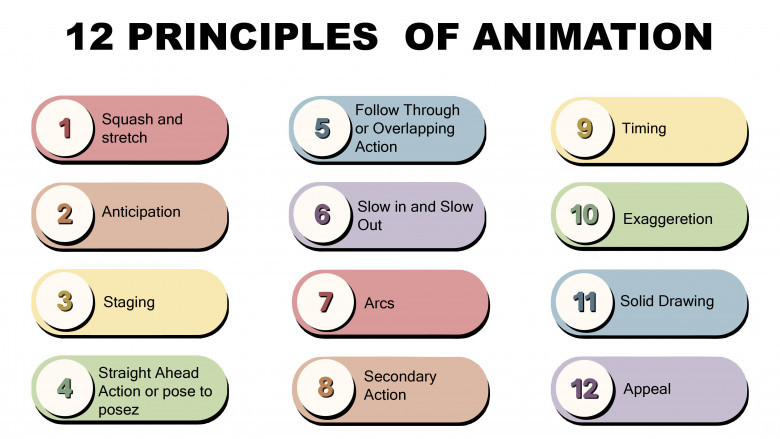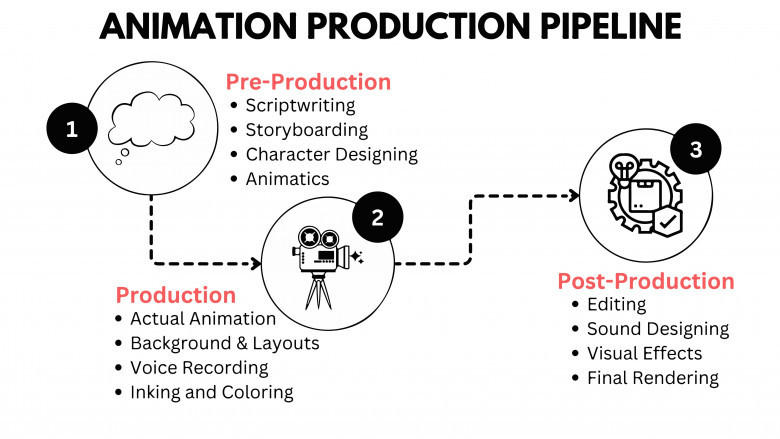2D animation is a rewarding career where creativity meets technical skill to bring stories and characters to life. With 10+ years in animation, I’ll guide you from the basics to landing your first job. Whether you're a beginner or looking to improve, this guide will help you master the art of turning still images into dynamic motion. Let’s dive in and bring your ideas to life!
2D animation is a vibrant and expressive art form that brings characters and stories to life on a flat surface, using only height and width. Unlike 3D animation, which adds depth and realism, 2D relies on bold lines, dynamic movement, and creative visual styles to capture the viewer’s imagination. Whether it’s a hand-drawn classic like Tom and Jerry or a sleek digital cartoon-like Adventure Time, 2D animation has a timeless charm that continues to entertain audiences of all ages. Traditionally, every frame was painstakingly drawn by hand—a labor of love seen in early Disney films like Snow White.
Today, thanks to powerful digital tools like Adobe Animate and Toon Boom Harmony, animators can create fluid, eye-catching scenes with greater speed and flexibility. From emotional storytelling in anime like Naruto to the quirky humor of shows like Rick and Morty, 2D animation offers endless possibilities for creativity. Its visual simplicity often makes stories feel more personal, imaginative, and fun—reminding us that sometimes, all you need is a pencil (or a stylus) and a great idea to make magic happen on screen.
Drawing : Drawing is the foundation of 2D animation, making a solid understanding of anatomy, perspective, and shading absolutely essential. In this art form, animators breathe life into characters with just a few carefully placed strokes—every line holds meaning and intention. The ability to convey motion, emotion, and personality through simple drawings is what sets skilled animators apart.
Storytelling: Animation, at its core, is not an issue of motion; rather, it is an act of storytelling. If done well, animation conveys emotion and tells a story in a very detail-oriented way, able to render static images dynamic and engaging.

Software Proficiency:
Modern 2D animation heavily relies on digital tools. Proficiency in industry-standard software like Adobe Animate, Toon Boom Harmony, and Clip Studio Paint is crucial. These programs not only streamline the animation process but also enable animators to add intricate details and maintain a smooth workflow.
Understanding Motion:
A deep grasp of how living beings move is essential. Animators must apply key principles such as Squash and Stretch, Anticipation, and Follow-Through to create believable, expressive motion that resonates with viewers.
Understanding these essential skills will help you make informed decisions—whether you're becoming an animator or hiring one. By recognizing what truly matters, you can ensure that your animation project is handled with skill, creativity, and professionalism, resulting in a high-quality final product that captivates your audience.
Understanding these essential skills will help you make informed decisions—whether you're becoming an animator or hiring one. By recognizing what truly matters, you can ensure that your animation project is handled with skill, creativity, and professionalism, resulting in a high-quality final product that captivates your audience.
Formal Education:
Many aspiring animators begin their journey with a degree in animation, graphic design, or related fields. These programs provide a strong foundation in both the artistic and technical aspects of animation.
Workshops:
Workshops offer hands-on experience and the chance to sharpen specific skills. They’re also excellent for networking and learning from industry professionals in a focused setting.
Online Courses and Tutorials:
There’s a wealth of free and paid online resources available—from structured platforms like Coursera and Skillshare to in-depth YouTube tutorials. These allow you to learn at your own pace, covering everything from basic principles to advanced animation techniques.
Self-Study and Practice:
Consistent practice is one of the most powerful tools for growth. Creating personal projects helps reinforce your skills, build your portfolio, and develop your unique animation style. The more you animate, the better—and more confident—you’ll become.
Animation is not a one-size-fits-all field. Here are some of the primary types:
1. 2D Animation : This classic form of animation involves creating characters and scenes in a two-dimensional space. Examples include hand-drawn cartoons and vector-based graphics.
2. 3D Animation : A more modern approach, 3D animation utilizes computer software to create three-dimensional models. It is widely used in movies, video games, and virtual reality.
3. Stop Motion Animation : This technique involves physically manipulating objects and photographing them frame by frame. Claymation and puppet animation are common examples.
4. Motion Graphics : Often used in multimedia projects, motion graphics consist of pieces of animation or digital footage that create the illusion of motion, usually accompanied by audio.

The 12 Principles of Animation
1. Squash and Stretch – Adds weight and flexibility to objects, like a ball squashing on impact and stretching in motion.
2. Anticipation – Prepares the audience for an action, such as crouching before a jump.
3. Staging – Directs focus to what's important in a scene through clear composition and timing.
4. Straight Ahead vs. Pose to Pose – Two animation methods: fluid and spontaneous (straight ahead) vs. planned keyframes (pose to pose).
5. Follow Through and Overlapping Action – Body parts continue moving after the main action, adding realism (like flapping ears after a stop).
6. Slow In and Slow Out – Adds natural movement by easing into and out of actions with extra frames.
7. Arcs – Natural motion follows curved paths; arcs make movement look fluid and organic.
8. Secondary Action – Supporting actions like facial expressions or swaying hair that enhance the main motion.
9. Timing – Controls the speed of actions to reflect weight, mood, and realism.
10. Exaggeration – Enhances movement or emotion to make scenes more dynamic and expressive.
11. Solid Drawing – Understanding form, weight, and anatomy gives 2D characters a 3D feel.
12. Appeal – Characters must be interesting and engaging, whether hero or villain.
Imagine the animation production pipeline to be a kind of roadmap that ushers a project from an idea to some cool animated piece. This pipeline consists of:

This stage adds the finishing touches and brings everything together to create a complete and polished film.
Editing – All animated scenes are assembled to ensure continuity, pacing, and coherence.
Sound Design – Music, sound effects, and audio enhancements enrich the atmosphere and emotional tone of the film.
Visual Effects (VFX) – Lighting, shadows, and other visual enhancements are applied to add depth and realism.
Final Render – The completed animation is exported in its final format, making it ready for distribution or screening.
Did you like this post? Tell us
Leave a comment
Log in with your itch.io account to leave a comment.